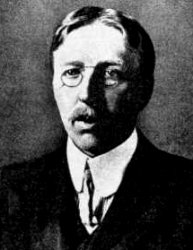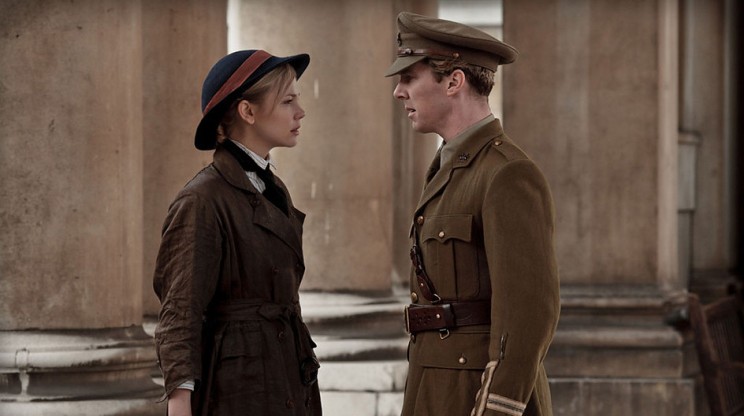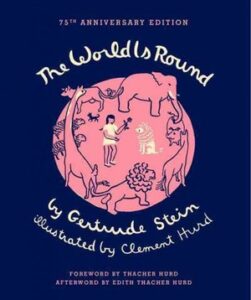 The Morgan Library is hosting an exhibit called “Ernest Hemingway: Between Two Wars.”
The Morgan Library is hosting an exhibit called “Ernest Hemingway: Between Two Wars.”
Some of the items on display include early short stories, notebooks, manuscripts, pictures, and letters between the Nobel Prize-winning author and several beloved writers such as Gertrude Stein and F. Scott Fitzgerald. A closing date has been set for Jan, 31, 2016.
Here’s more information from The Morgan Library’s website: “This is the first ever major museum exhibition devoted to the work of Ernest Hemingway (1899–1961), one of the most celebrated American authors of the 20th century…Focusing on the inter-war years, the exhibition explores the most consistently creative phase of Hemingway’s career and includes inscribed copies of his books, a rarely-seen 1929 oil portrait, photographs, and personal items.”

By Max Saunders
One definition of a classic book is a work which inspires repeated metamorphoses. Romeo and Juliet, Gulliver’s Travels, Frankenstein, Dracula, The Great Gatsby don’t just wait in their original forms to be watched or read, but continually migrate from one medium to another: painting, opera, melodrama, dramatization, film, comic-strip. New technologies inspire further reincarnations. Sometimes it’s a matter of transferring a version from one medium to another — audio recordings to digital files, say. More often, different technologies and different markets encourage new realisations: Hitchcock’s Psycho re-shot in colour; French or German films remade for American audiences; widescreen or 3D remakes of classic movies or stories.
 Cinema is notoriously hungry for adaptations of literary works. The adaptation that’s been preoccupying me lately is the BBC/HBO version of Parade’s End, the series of four novels about the Edwardian era and the First World War, written by Ford Madox Ford. Ford was British, but an unusually cosmopolitan and bohemian kind of Brit. His father was a German émigré, a musicologist who ended up as music critic for the London Times. His mother was an artist, the daughter of the Pre-Raphaelite painter Ford Madox Brown. Ford was educated trilingually, in French and German as well as English. When he was introduced to Joseph Conrad at the turn of the century, they decided to collaborate on a novel, and went on over a decade to produce three collaborative books. He also got to know Henry James and Stephen Crane at this time — the two Americans were also living nearby, on the Southeast coast of England. Americans were to prove increasingly important in Ford’s life. He moved to London in 1907, and soon set up the literary magazine that helped define pre-war modernism: the English Review. He had a gift for discovering new talent, and was soon publishing D. H. Lawrence and Wyndham Lewis alongside James and Conrad. But it was Ezra Pound, who he also met and published at this time, who was to become his most important literary friend after Conrad.
Cinema is notoriously hungry for adaptations of literary works. The adaptation that’s been preoccupying me lately is the BBC/HBO version of Parade’s End, the series of four novels about the Edwardian era and the First World War, written by Ford Madox Ford. Ford was British, but an unusually cosmopolitan and bohemian kind of Brit. His father was a German émigré, a musicologist who ended up as music critic for the London Times. His mother was an artist, the daughter of the Pre-Raphaelite painter Ford Madox Brown. Ford was educated trilingually, in French and German as well as English. When he was introduced to Joseph Conrad at the turn of the century, they decided to collaborate on a novel, and went on over a decade to produce three collaborative books. He also got to know Henry James and Stephen Crane at this time — the two Americans were also living nearby, on the Southeast coast of England. Americans were to prove increasingly important in Ford’s life. He moved to London in 1907, and soon set up the literary magazine that helped define pre-war modernism: the English Review. He had a gift for discovering new talent, and was soon publishing D. H. Lawrence and Wyndham Lewis alongside James and Conrad. But it was Ezra Pound, who he also met and published at this time, who was to become his most important literary friend after Conrad.
Ford served in the First World War, getting injured and suffering from shell shock in the Battle of the Somme. He moved to France after the war, where he soon joined forces with Pound again, to form another influential modernist magazine, the transatlantic review, which published Joyce, Gertrude Stein, and Jean Rhys. Ford took on another young American, Ernest Hemingway, as his sub-editor. Ford held regular soirees, either in a working class dance-hall with a bar that he’d commandeered, or in the studio he lived in with his partner, the Australian painter Stella Bowen. He found himself at the centre of the (largely American) expatriate artist community in the Paris of the 20s. And it was there, and in Provence in the winters, and partly in New York, that he wrote the four novels of Parade’s End, that made him a celebrity in the US. He spent an increasing amount of time in the US through the 20s and 30s, based on Fifth Avenue in New York, becoming a writer in residence in the small liberal arts Olivet College in Michigan, spending time with writer-friends like Theodore Dreiser and William Carlos Williams, and among the younger generation, Robert Lowell and e. e. cummings.
Parade’s End (1924-28) has been dramatized for TV by Sir Tom Stoppard. It has to be one of the most challenging books to film; but Stoppard has the theatrical ingenuity, and experience, to bring it off. It’s a classic work of Modernism: with a non-linear time-scheme that can jump around in disconcerting ways; dense experimental writing that plays with styles and techniques. Though it includes some of the most brilliant conversations in the British novel, and its characters have a strong dramatic presence, much of it is inherently un-dramatic and, you might have thought, unfilmable: long interior monologues, descriptions of what characters see and feel; and — perhaps hardest of all to convey in drama — moments when they don’t say what they feel, or do what we might expect of them. Imagine T. S. Eliot’s ‘The Waste Land’, populated by Chekhovian characters, but set on the Western Front.
I’ve worked on Ford for some years, yet still find him engaging, tantalising, often incomprehensibly rewarding, so I was watching Parade’s End with fascination. [Warning: Spoilers ahead.]
Click here to view the embedded video.
Stoppard and the director, Susanna White, have done an extraordinary job in transforming this rich and complex text into a dramatic line that is at once lucid and moving. Sometimes where Ford just mentions an event in passing, the adaptation dramatizes the scene for us. The protagonist is Christopher Tietjens, a man of high-Tory principle — a paradoxical mix of extreme formality and unconventional intelligence – is played outstandingly by Benedict Cumberbatch, with a rare gift to convey thought behind Tietjens’ taciturn exterior. In the novel’s backstory, Christopher has been seduced in a railway carriage by Sylvia, who thinks she’s pregnant by another man. The TV version adds a conversation as they meet in the train; then cuts rapidly to a sex scene. It’s more than just a hook for viewers unconcerned about textual fidelity, though. What it establishes is what Ford only hints at through the novel, and what would be missed without Tietjen’s brooding thoughts about Sylvia: that her outrageousness turns him on as much as it torments him. In another example, where the novelist can describe the gossip circulating like wildfire in this select upper-class social world, the dramatist needs to give it a location; so Stoppard invents a scene at an Eton cricket match for several of the characters to meet, and insult Valentine Wannop, while she and Tietjens are trying not to have the affair that everyone assumes they are already having. Valentine is an ardent suffragette. In the novel, she and Tietjens argue about women and politics and education. Stoppard introduces a real historical event from the period — a Suffragette slashing Velasquez’s ‘Rokeby Venus’ in the National Gallery — as a way of saying it visually; and then complicating it beautifully with another intensely visual interpolated moment. In the book Ford has Valentine unconcsciously rearranging the cushions on her sofa as she waits to see Tietjens the evening before he’s posted back to the war. When she becomes aware that she’s fiddling with the cushions because she’s anticipating a love-scene with him, the adaptation disconcertingly places Valentine nude on her sofa in the same position as the ‘Rokeby Venus’ — in a flash both sexualizing her politics and politicizing her sexuality.
Such changes cause a double-take in viewers who know the novels. But they’re never gratuitous, and always respond to something genuine in the writing.
Perhaps the most striking transformation comes during one of the most amazing moments in the second volume, No More Parades. Tietjens is back in France, stationed at a Base Camp in Rouen, struggling against the military bureaucracy to get drafts of troops ready to be sent to the Front Line. Sylvia, who can’t help loving Tietjens though he drives her mad, has somehow managed to get across the Channel and pursue him to his Regiment. She has been unfaithful, and he is determined not to sleep with her; but because his principles won’t let a man divorce a woman, he feels obliged to share her hotel room so as not to humiliate her publicly. She is determined to seduce him once more; but has been flirting with other officers in the hotel, two of whom also end up in their bedroom in a drunken brawl. It’s an extraordinary moment of frustration, hysteria, terror (there has been a bombardment that evening), confusion, and farce. In the book we sense Sylvia’s seductive power, and that Tietjens isn’t immune to it, even though by then in love with Valentine. He resists. But in the film version, they kiss passionately before being interrupted.

Valentine and Christopher. Adelaide Clemens and Benedict Cumberbatch in Parade’s End. (c) BBC/HBO.
The scene may have been changed to emphasize the power she still has over Tietjens: as if, paradoxically, he needs to be seen to succumb for a moment to make his resistance to her the more heroic. The change that’s going to exercise enthusiasts of the novels, though, is the way three of the five episodes were devoted to the first novel, Some Do Not…; and roughly one each to the second and third; with very little of the fourth volume, Last Post, being included at all. The third volume, A Man Could Stand Up — ends where the adaptation does, with Christopher and Valentine finally being united on Armistice night, a suitably dramatic and symbolic as well as romantic climax. Last Post is set in the 1920s and deals with post-war reconstruction. One can see why it would have been the hardest to film: much of it is interior monologue, and though Tietjens is often the subject of it he is absent for most of the book. Some crucial scenes from the action of the earlier books is only supplied as characters remember them in Last Post, such as when Syliva turns up after the Armistice night party lying to Christopher and Valentine that she has cancer in an attempt to frustrate their union. Stoppard incorporates this into the last episode, but he writes new dialogue for it to give it a kind of closure the novels studiedly resist. Valentine challenges her as a liar, and from Tietjens’ reaction, Sylvia appears to recognize the reality of his love for her and gives her their blessing.
Rebecca Hall, playing Sylvia, has been so brilliantly and scathingly sarcastic all the way through that this change of heart — moving though it is — might seem out of character: even the character the film gives her, which is arguably more sympathetic than the one most readers find in the novel. Yet her reversal is in Last Post. But what triggers it there, much later on, is when she confronts Valentine but finds her pregnant. Even the genius of Tom Stoppard couldn’t make that happen before Valentine and Christopher have been able to make love. But there are two other factors, which he was able to shift from the post-war time of Last Post into the war’s endgame of the last episode. One is that Sylvia has focused her plotting on a new object. Refusing the role of the abandoned wife of Tietjens, she has now set her sights on General Campion, and begun scheming to get him made Viceroy of India. The other is that she feels she has already dealt Tietjens a devastating blow, in getting the ‘Great Tree’ at his ancestral stately home of Groby cut down. In the book she does this after the war by encouraging the American who’s leasing it to get it felled. In the film she’s done it before the Armistice; she’s at Groby; Tietjens visits there; has a Stoppard scene with Sylvia arranged in her bed like a Pre-Raphaelite vision in a last attempt to re-seduce him, which fails partly because of his anger over the tree. In the books the Great Tree represents the Tietjens family, continuity, even history itself. Ford writes a sentence about how the villagers “would ask permission to hang rags and things from the boughs,” but Stoppard and White make that image of the tree, all decorated with trinkets and charms, a much more prominent motif, returning to it throughout the series, and turning it into a symbol of superstition and magic. But then Stoppard characteristically plays on the motif, and has Christopher take a couple of blocks of wood from the felled tree back to London. One he gives to his brother, in a wonderfully tangible and taciturn gesture of renouncing the whole estate and the history it stands for. The other he uses in his flat, throwing whisky over it in the fireplace to light a fire to keep himself and Valentine warm. That gesture shows how it isn’t just Sylvia who is saying ‘Goodbye to All That’, but all the major characters are anticipating the life that, though the series doesn’t show it, Ford presents in the beautifully elegiac Last Post.
Max Saunders is author of Ford Madox Ford: A Dual Life (OUP, 1996/2012), and editor of Some Do Not . . ., the first volume of Ford’s Parade’s End (Manchester: Carcanet, 2010) and Ford’s The Good Soldier (Oxford: OUP, 2012). He was interviewed by Alan Yentob for the Culture Show’s ‘Who on Earth was Ford Madox Ford’ (BBC 2; 1 September 2012), and his blog on Ford’s life and work can be read on the OUPblog and New Statesman.
For over 100 years Oxford World’s Classics has made available the broadest spectrum of literature from around the globe. Each affordable volume reflects Oxford’s commitment to scholarship, providing the most accurate text plus a wealth of other valuable features, including expert introductions by leading authorities, voluminous notes to clarify the text, up-to-date bibliographies for further study, and much more. You can follow Oxford World’s Classics on Twitter and Facebook.
Subscribe to the OUPblog via email or RSS.
Subscribe to only literature articles on the OUPblog via email or RSS.
Image credits: (1) Portrait of Ford Madox Ford (Source: Wikimedia Commons); (2) Still from BBC2 adaption of Parade’s End. (Source: bbc.co.uk).
The post Ford Madox Ford and unfilmable Modernism appeared first on OUPblog.

It’s been a wonderful Bookman birthday day today. The cake came out so good and it couldn’t have been simpler. It is basically a single-layer chocolate cake with some cherries in it topped with a can of cherry pie filling and then drizzled with chocolate. What could be easier? And because of the cherries we can pretend that it is nutritious!
I began reading My Poets by Maureen McLane today and very quickly became friends with this book.
The first chapter is short and is a “Proem in the form of a Q&A” Here is a sample:
Why do you read poetry?
I caught this morning morning’s minion.
Why do you read poetry?
Batter my heart.
Why to you read poetry?
I have wasted my life.
Other questions include what is the first poem you remember, why poetry, and why do you write poetry? Here are a couple answers to the last question:
Why do you write poetry?
My purpose here is to advance into
the sense of the weather.
Why do you write poetry?
I sing to use the Waiting.
As if that weren’t marvelous enough, chapter two muses about the word “kankedort” which apparently only appears in Chaucer’s Troilus and Criseyde. From there we move to a chapter called “My Impasses” in which McLane talks about two poetry classes she took as a college freshman in 1985, one of them taught by Helen Vendler. She talks about reading poetry and reading poetry, good readings and bad readings, about finding a way into a poem and being stuck on the outside even though you badly want to understand. And she talks about how, years later, a poem that was so confusing and impossible originally can suddenly open up and let you in and mean so much. It is a really wonderful chapter that I might have to reread and write about because she says so much that is true.
And then chapter four. Oh, I had to stop myself in the middle of it so I wouldn’t rush to the end because it is so utterly fun. Chapter four is called “My Elizabeth Bishop / (My Gertrude Stein)” and it is written in the style of Stein. For her undergraduate thesis McLane decided she was going to write about Stein but Stein resisted her and a gift from a mentor of a book of Elizabeth Bishop poems turned out to be a wonderful discovery and saved her thesis from disaster. I must give you a taste of the chapter so here is how it begins:
My Elizabeth Bishop begins with Gertrude Stein.
This is not usual.
Bishop is unusual but not in the way Stein is unusual.
I was not used to Gertrude Stein and found I could not get used
to Stein though I tried.
I was struggling to find a topic for my undergraduate thesis.
This seemed the most important thing in the world.
Whatever is the world to you is the most important thing to
you.
I would be making myself in this thing.
I was always making myself or being made.
This was unavoidable.
I was planning on being made by Gertrude Stein but she was not
cooperating.
She was operating on another plane a fractured cubist grid I
could not make out.
And it appears to go on like this for entire 27 pages of the chapter.
I suppose this kind of book might not be for everyone, but oh, I have a little crush on it at the moment and hope that we manage to be best friends by the final page.
Filed under:
Books,
Memoir/Biography,
Poetry Tagged:
Elizabeth Bi
 The World is Round (illustrated by Clement Hurd, North Point Press, 1988) is technically not a poetry book, per se, although its author, Gertrude Stein, might argue otherwise. I discovered it through a post a friend linked me to on the most excellent blog, Brain Pickings. Now some of you might wonder how Gertrude Stein came to write a children’s book in the first place, and the story has much to do with the early development of children’s book publishing in the U.S. in the 1930′s. Stein was asked by the youthful start-up publishing company of Young Scott Books (founded in 1938) whose mandate was to publish illustrated childrens’ books to submit a manuscript for their consideration. Stein submitted The World is Round, a story of a girl named Rose (of course!) and her cousin Willie. Rose was based on a child who was the daughter of Gertrude Stein’s neighbor in Bilignin, a small farming community located in the French alps.
The World is Round (illustrated by Clement Hurd, North Point Press, 1988) is technically not a poetry book, per se, although its author, Gertrude Stein, might argue otherwise. I discovered it through a post a friend linked me to on the most excellent blog, Brain Pickings. Now some of you might wonder how Gertrude Stein came to write a children’s book in the first place, and the story has much to do with the early development of children’s book publishing in the U.S. in the 1930′s. Stein was asked by the youthful start-up publishing company of Young Scott Books (founded in 1938) whose mandate was to publish illustrated childrens’ books to submit a manuscript for their consideration. Stein submitted The World is Round, a story of a girl named Rose (of course!) and her cousin Willie. Rose was based on a child who was the daughter of Gertrude Stein’s neighbor in Bilignin, a small farming community located in the French alps.
The World is Round contains the story of Rose and Willie in 32 micro-chapters of the kind of lilting and somewhat nonsensical poetic like prose that is distinctively Stein. Who cannot help but recognize Stein’s playful existentialism in such lines as “I am a little girl and my name is Rose, Rose is my name./ Why am I a little girl/And why is my name Rose/And when am I a little girl/And when is my name Rose/And where am I little girl/And where is my name Rose … “ Granted, this may not be your child’s cup of tea when it comes to bedtime reading, but sometimes I like to throw in a little twist of lemon to give a bit of complexity to the flavors of narrative one gives to one’s child. My daughter liked the early chapters of this book, probably because they had to do with dogs, but has not warmed to it much since. But she doesn’t mind my continuing with this book so I shall go on with it til the end. As one reviewer said, “It is meant to be read aloud, a little at a time, and the adult who does so will find himself saying, ‘I remember thinking like this,’ and succumbing to the seductive quality of phrases, which will make it probably the most quotable book of the season.’ My edition has a lengthy but informative afterword that also contains information about the illustrator Clement Hurd and the artwork he did for the book.
Poetry Friday this Good Friday is hosted by Robyn at Read Write Howl.
My latest column is up at Strange Horizons: "Learning to Write".
I didn't realize this would be SH's eighth anniversary issue. Eight years of weekly doses of fiction, poetry, essays, articles, etc. An impressive accomplishment, especially given that everyone on staff is a volunteer. They're all a joy to work with, and I think the results are extraordinary in many ways, so congratulations to all of the various Strange Horizon writers and staff over the years.
The new column is a strange one, but then, most of them are. It's centered on Jules Renard's journals , recently reissued by Tin House Books, and appearances are also made by Jacques Roubaud's Some Thing Black
, recently reissued by Tin House Books, and appearances are also made by Jacques Roubaud's Some Thing Black and Gertrude Stein's How to Write
and Gertrude Stein's How to Write .
.
By the way, if you ever teach an intro composition class or something like that, I recommend sticking Stein's How to Write on a shelf, and when a student asks you for the "secret" or writing (or anything to that effect), tell them it's in that book over there on the shelf. Tell them any page of that book will teach them more about writing than anything else. Then watch their face as they read. (Okay, yes, it's a little cruel, but still...)
 The Morgan Library is hosting an exhibit called “Ernest Hemingway: Between Two Wars.”
The Morgan Library is hosting an exhibit called “Ernest Hemingway: Between Two Wars.”








 What would Gertrude Stein write if she started drinking and texting? In a series of drawings, The Paris Review‘s Jessica Gaynor
What would Gertrude Stein write if she started drinking and texting? In a series of drawings, The Paris Review‘s Jessica Gaynor 


I love the party feet tutorial! How could you not dance around in those?
Love the big feet! It’s up there with the blue fur leggings.
Take a look at William Faulkner’s The Wishing Tree. I’ll leave it to others to decide its quality, though if I remember correctly the illustrations are very nice.